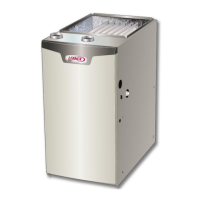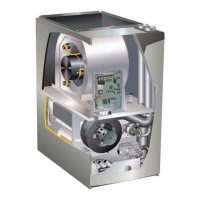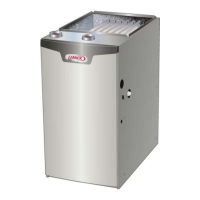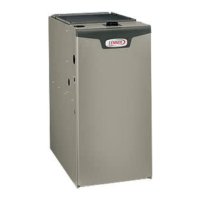Page 24
TYPICAL AIR INTAKE PIPE CONNECTIONS
NON−DIRECT VENT APPLICATIONS
AIR
INTAKE
SCREEN
(Provided)
NOTE - Air intake screen and elbow may be rotated, so that
screen may be positioned to face forward or to either side.
FIGURE 32
Follow the next two steps when installing the unit in
Non-Direct Vent applications where combustion air is tak-
en from indoors and ue gases are discharged outdoors.
1 - Use eld-provided materials and the factory-provided
air intake screen to route the intake piping as shown
in FIGURE 32. Maintain a minimum clearance of
3” (76mm) around the air intake opening. The air
intake opening (with the protective screen) should
always be directed forward, or sideways.
2 - Use cement to secure the intake pipe to the connector,
if desired.
General Guidelines for Vent Terminations
In Non-Direct Vent applications, combustion air is taken
from indoors and the ue gases are discharged to the out-
doors. The EL296DFV is then classied as a non-direct
vent, Category IV gas furnace.
In Direct Vent applications, combustion air is taken from
outdoors and the ue gases are discharged to the out-
doors. The EL296DFV is then classied as a direct vent,
Category IV gas furnace.
In both Non-Direct Vent and Direct Vent applications, the
vent termination is limited by local building codes. In the
absence of local codes, refer to the current National Fuel
Gas Code ANSI Z223-1/NFPA 54 in U.S.A., and current
CSA-B149 Natural Gas and Propane Installation Codes in
Canada for details.
Position termination according to location given in FIG-
URE 34 or FIGURE 35. In addition, position termination so
it is free from any obstructions and 12” above the average
snow accumulation.
At vent termination, care must be taken to maintain protec-
tive coatings over building materials (prolonged exposure
to exhaust condensate can destroy protective coatings).
It is recommended that the exhaust outlet not be located
within 6 feet (1.8m) of an outdoor AC unit because the
condensate can damage the painted coating.
NOTE - See TABLE 8 for maximum allowed exhaust pipe
length without insulation in unconditioned space during
winter design temperatures below 32°F (0°C). If required
exhaust pipe should be insulated with 1/2” (13mm) Ar-
maex or equivalent. In extreme cold climate areas, 3/4”
(19mm) Armaex or equivalent may be necessary. Insu-
lation must be protected from deterioration. Armaex with
UV protection is permissable. Basements or other en-
closed areas that are not exposed to the outdoor ambient
temperature and are above 32 degrees F (0°C) are to be
considered conditioned spaces.
IMPORTANT
Do not use screens or perforated metal in exhaust
terminations. Doing so will cause freeze-ups and may
block the terminations.
IMPORTANT
For Canadian Installations Only: In accordance to CSA
International B149 installation codes, the minimum
allowed distance between the combustion air intake inlet
and the exhaust outlet of other appliances shall not be
less than 12 inches (305mm).
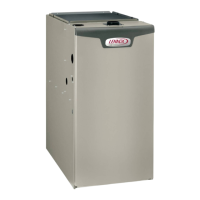
